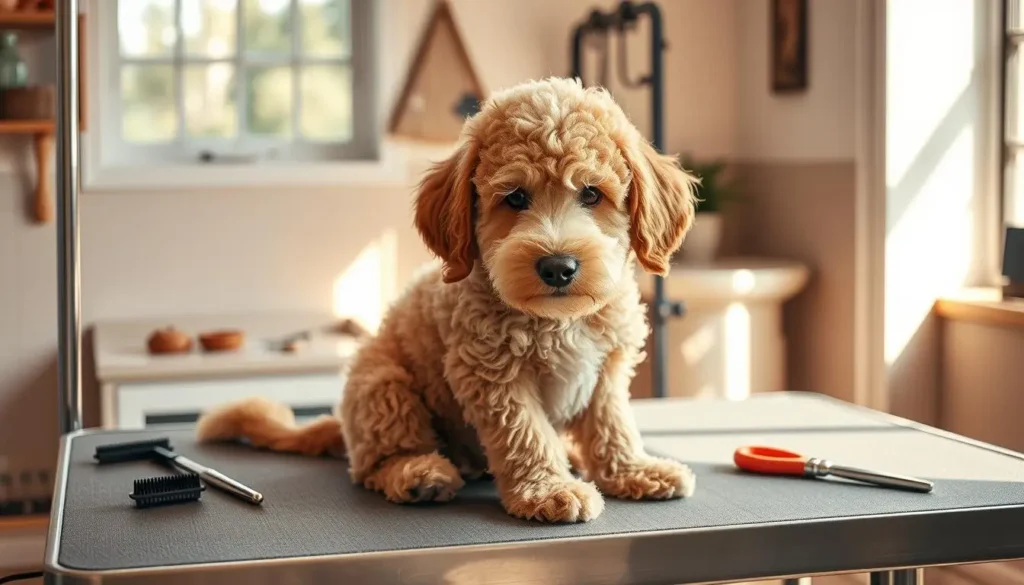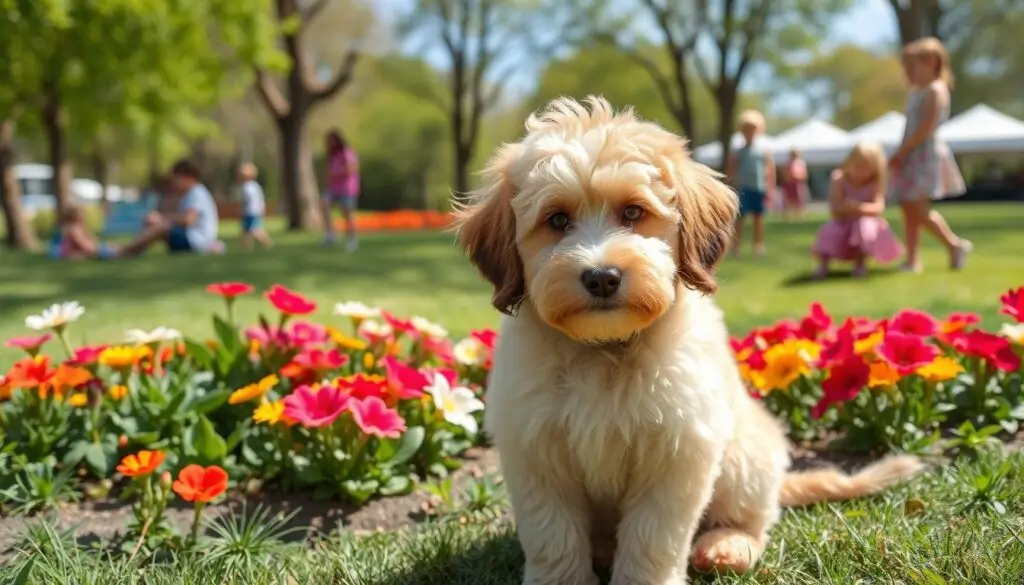Why The Mini Australian Labradoodle Is The Perfect Family Dog
The mini Australian Labradoodle is a favorite among families. It’s known for being gentle, having a low-shedding coat, and being very smart. This makes it a perfect fit for many families.
Its hypoallergenic coat is great for families with allergies. The mini Labradoodle is also easy to train. It learns commands and tricks fast.
We’ll look into why the mini Australian Labradoodle is ideal for families. This includes its origins, temperament, grooming needs, and being a great family pet.
Table of Contents
Key Takeaways
- The mini Australian Labradoodle is a hypoallergenic breed, suitable for families with allergy sufferers.
- The Australian Labradoodle is known for its intelligence, derived from its parent breeds, the Labrador Retriever and the Poodle.
- Mini Labradoodles are easy to train and exhibit a friendly and gentle disposition.
- The breed is compact in size, making it adaptable for both apartment living and larger homes.
- The mini Australian Labradoodle is a popular choice for families due to its low-shedding coat and high intelligence.
- The breed is suitable for families with children, as it is patient and exhibits social interaction.
Understanding the Mini Australian Labradoodle Breed
The Mini Australian Labradoodle is a popular breed known for its hypoallergenic coat and friendly nature. It was created by mixing a Labrador Retriever with a Standard Poodle. This was to make a guide dog for people with allergies.
Today, the small Australian labradoodle is recognized as a distinct breed. It’s smart, loyal, and loves people. This makes it a great pet for families and individuals. It can do well in many homes, from apartments to big houses.
The mini Australian labradoodle has a low-shedding coat, is very smart, and full of energy. Here are some key features of this breed:
- Hypoallergenic coat: The mini Australian labradoodle has a low-shedding coat that makes it an excellent choice for individuals with allergies.
- Intelligence: The mini Australian labradoodle is highly intelligent and responds well to training.
- Energetic personality: The mini Australian labradoodle is an energetic breed that requires regular exercise and mental stimulation.
Knowing the mini Australian labradoodle’s traits and needs helps you decide if it’s right for you. With its friendly nature and easy-to-maintain coat, it’s a great choice for many dog lovers.
Physical Characteristics and Size Specifications
The miniature Australian labradoodle is a great choice for families with limited space. It weighs 15-25 pounds and stands 14-16 inches tall. Its muscular build and broad chest make it sturdy. Plus, its short coat is easy to keep clean and comes in many colors.
This breed’s size is a big plus, making it a favorite among australian labradoodle breeders. It’s perfect for apartment living or small yards. But, remember, it’s an active dog that needs regular exercise to stay happy and healthy.
Some key characteristics of the miniature Australian labradoodle include:
- Weight: 15-25 pounds
- Height: 14-16 inches
- Coat: Short, easy-to-maintain
- Colors: Variety of colors available
If you’re thinking of getting a miniature Australian labradoodle, look for reputable australian labradoodle breeders. They focus on the health and happiness of their dogs. This way, you’ll get a happy and healthy companion.
The Unique Temperament of Mini Australian Labradoodles
Mini Australian Labradoodle puppies have a temperament that’s hard to resist. They are smart, friendly, and love to please. This makes them easy to train and eager to learn.
They are very smart and easy to train, which is why they’re great family pets. With the right training and socialization, they do well in active families. They also get along well with kids and other pets, especially if they’re socialized early.
Intelligence and Trainability
Mini labradoodles are among the smartest dog breeds. Their smarts and love to please make them easy to train. They do best with positive training, where they get rewards for good behavior.
Social Nature
Mini Australian Labradoodles love being around people and other pets. They are social dogs that enjoy being part of the family. This makes them perfect for families with kids, as they are gentle and loving.
Compatibility with Children
Mini labradoodles are great with kids, making them a top choice for families. They are patient and loving, which helps them handle kids’ rough play. But, it’s important to teach kids how to safely interact with dogs.
Grooming Requirements and Coat Types
Exploring the mini australian labradoodle and australian labradoodle breeds, we find their grooming needs are key. The mini australian labradoodle has a low-shedding coat. This coat needs regular grooming to avoid matting and tangling. There are fleece and wool coats, each with its own grooming needs.
Here are the grooming essentials for a mini australian labradoodle:
- Fleece coats need brushing 5-7 times a week to stop tangling
- Wool coats need about 2 days of brushing a week because they’re thicker
- F3 or F3B Labradoodles should see a groomer every 4-6 weeks for trimming
Managing the coat well can cut down on professional grooming costs. Grooming a mini australian labradoodle is a big commitment. Yet, many owners find it worth it. With proper care, the coat becomes a stunning feature of the breed.

Regular grooming also helps reduce shedding, especially in F3 dogs. Knowing the grooming needs and coat types helps owners care for their pets better.
| Coat Type | Grooming Requirements |
|---|---|
| Fleece Coat | Brushing 5-7 times a week |
| Wool Coat | Brushing 2 days a week |
| F3 or F3B Labradoodle | Grooming every 4-6 weeks |
Exercise Needs and Activity Levels
As a small australian labradoodle owner, it’s key to know how much exercise your pet needs. Mini aussie labradoodles need regular activity to avoid boredom and bad behavior. We suggest giving your mini australian labradoodle at least 45 minutes of exercise twice a day.
The amount of exercise a mini aussie labradoodle needs changes with age. Puppies under 2 years old should walk up to 1 to 2 miles at a time. Adult labradoodles can walk between 5 to 10 miles. Watch for signs of too much exercise, like heavy panting, not wanting to keep going, or limping.
Adult mini aussie labradoodles can enjoy brisk walks, jogs, fetch, frisbee games, swimming, agility training, and puzzle toys. For older labradoodles, choose low-impact activities and shorter, more frequent sessions. Swimming is a great option for seniors.
Here are some exercise guidelines for mini australian labradoodles:
- 10 minutes up to 3 times per day at 2 months
- 15 minutes up to 3 times per day at 4 months
- 25 minutes up to 3 times per day from 6–12 months
- 45–90 minutes up to 2 times per day at 12–24 months
- 45–90 minutes up to 2 times per day as adults
Health Considerations and Life Expectancy
Understanding the health of australian labradoodle puppies is key. Reputable australian labradoodle breeders focus on their dogs’ health. It’s important for owners to know about possible health issues to care for their pets well.
Common health problems in australian labradoodle puppies include hip dysplasia, progressive retinal atrophy (PRA), and ear infections. Regular vet visits can catch these early. Genetic tests and proper care can help prevent these issues.
Here are some key health considerations for australian labradoodle breeders and owners:
- Hip dysplasia: a genetic condition that can lead to arthritis and mobility issues
- Progressive retinal atrophy (PRA): a degenerative eye disorder that can cause blindness
- Ear infections: common in dogs with floppy ears, and can be prevented with regular cleaning and checkups

With the right care, australian labradoodle puppies can live 12-15 years. Working with good australian labradoodle breeders and focusing on their health ensures they live happily and healthily.
| Health Issue | Description | Prevention |
|---|---|---|
| Hip Dysplasia | A genetic condition that can lead to arthritis and mobility issues | Genetic testing, proper care and exercise |
| Progressive Retinal Atrophy (PRA) | A degenerative eye disorder that can cause blindness | Regular eye checkups, genetic testing |
| Ear Infections | Common in dogs with floppy ears, and can be prevented with regular cleaning and checkups | Regular ear cleaning and checkups |
Training Your Mini Australian Labradoodle
Training a mini labradoodle needs patience, consistency, and positive feedback. It’s key to understand early socialization and basic obedience. This is vital for your australian mini labradoodle’s growth.
Creating a routine is important. A regular schedule helps your puppy learn faster. Positive reinforcement can speed up learning by about 50%.
Basic Obedience Training
Teaching basic commands like “sit,” “stay,” and “come” is crucial. Use positive methods to teach your mini labradoodle. Practice these commands in different places to help your dog learn in various settings.
Socialization Tips
Socializing your puppy is vital. Early socialization can reduce behavioral problems by 30% in adult dogs. Introduce your mini labradoodle to new people, dogs, and places early. This helps them become confident and well-adjusted.
Common Training Challenges
Housebreaking can be a challenge. Keeping a regular feeding schedule helps about 85% of dogs with their potty timing. Crate training works for about 70% of puppies with house training.
Training your australian mini labradoodle is a long-term commitment. With the right approach, your dog will become a well-behaved and loving friend.
Living with a Mini Australian Labradoodle
Living with a mini Australian Labradoodle is exciting. They are smart, social, and full of energy. This makes them perfect for families who love to stay active. They can do well in many homes, big or small.
One great thing about these dogs is their hypoallergenic coat. This is perfect for families with allergies. But, they need regular grooming, about every 4 to 6 weeks. It’s a big job, but it’s worth it for their love and company.
Here are some tips for living with a mini Australian Labradoodle:
- Ensure consistent physical activity and mental engagement to avoid boredom and prevent destructive behaviors.
- Create a dog-friendly home with plenty of space to run around
- Consider professional training to address any behavioral issues
By following these tips and doing your research, you can create a happy and healthy home for your miniature Australian Labradoodle. They are smart, loyal, and loving. It’s no wonder they’re becoming more popular as pets.
Every dog is different, so it’s important to understand your mini Australian Labradoodle’s personality and needs. With patience, love, and proper care, you can build a strong bond with your dog. Enjoy a lifelong friendship with them.
| Characteristics | Mini Australian Labradoodle |
|---|---|
| Size | 14-17 inches tall, 15-25 pounds |
| Coat | Hypoallergenic, requires regular grooming |
| Energy Level | High, requires regular exercise and mental stimulation |
Nutrition and Dietary Requirements
Feeding your mini australian labradoodle the right food is key. They need a diet rich in nutrients for growth and health. This diet should be balanced for both puppies and adult dogs.
A good diet for mini australian labradoodles includes proteins, fats, carbs, vitamins, and minerals. Foods like chicken, beef, and fish help build muscles. Carbs from brown rice, sweet potatoes, and oats give energy and fiber.
Puppy Feeding Guidelines
Puppies need a diet high in protein, at least 31%. They should eat 3-4 times a day to support their fast growth.
Adult Diet Recommendations
Adult mini australian labradoodles need a balanced diet with proteins, fats, and carbs. They should get at least 25% protein. The fat-to-protein ratio should be about 70%.
Special Dietary Considerations
Some mini australian labradoodles may have food allergies or sensitivities. It’s crucial to work with a vet for a custom diet. Supplements like omega-3 fatty acids can also help their health.
Choosing a Reputable Mini Australian Labradoodle Breeder
Finding a good mini Australian Labradoodle breeder is key. They should care about their dogs’ health and happiness. Look for australian labradoodle breeders who do health tests on their dogs. They should also give them vet care and socialize them early.
Here are some important things to think about when picking a breeder:
- Health testing: Make sure the breeder checks for genetic issues like hip dysplasia and PRA.
- Transparency: A good breeder will share health test results and talk openly about their breeding methods.
- Facility: The breeder’s place should be clean, safe, and big enough for the dogs.
- Support: Look for breeders who help after you get your puppy, showing they care about the puppy’s future.
By researching and picking a reputable mini labradoodle breeder, you’ll get a healthy, friendly puppy. Always visit the breeder, ask lots of questions, and focus on your puppy’s health and happiness.
Some top breeders belong to groups like the Australian Labradoodle Association of America (ALAA) or the Worldwide Australian Labradoodle Association (WALA). These groups set high standards for health and breeding. Choosing a reputable breeder means you’re getting a healthy puppy and supporting good breeding practices.
| Breeder Characteristics | Reputable Breeder | Irresponsible Breeder |
|---|---|---|
| Health Testing | Performs genetic testing and screens for common conditions | Does not perform health testing or is unclear about testing |
| Transparency | Provides health testing results and is transparent about breeding practices | Lacks transparency or refuses to provide health testing results |
| Facility | Clean, safe, and spacious facility | Unclean, unsafe, or cramped facility |
Conclusion: Is a Mini Australian Labradoodle Right for Your Family?
The Mini Australian Labradoodle is a great choice for many families. They have low-shedding coats, are smart, and friendly. This makes them perfect for homes with kids, as 90% of owners say they get along well.
They also fit well in different homes, from small apartments to big houses. This is because they adapt easily to various living situations, fitting about 80% of U.S. homes.
But, think about your family’s lifestyle and if you can give them the care they need. They need about an hour of exercise daily to stay happy and healthy. They also do best with owners who spend a lot of time with them.
Remember, they might cost more at the vet because of their health issues. Still, if you want a loyal, loving, and smart dog, a Mini Australian Labradoodle could be great. They can bring joy and support to many families in the U.S.

